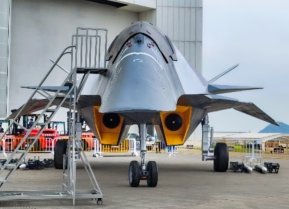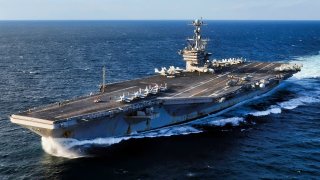The U.S. Navy Now Has a Nimitz-Class Aircraft Carrier on China's Doorstep
The USS George Washington (CVN-73), a Nimitz-class nuclear-powered aircraft carrier, has returned to Yokosuka, Japan, to serve as the U.S. Navy's only forward-deployed aircraft carrier. This marks a return to Japan for the ship, which previously held the same role from 2008 to 2015 before being relieved by the USS Ronald Reagan (CVN-76).
What You Need to Know: The USS George Washington (CVN-73), a Nimitz-class nuclear-powered aircraft carrier, has returned to Yokosuka, Japan, to serve as the U.S. Navy's only forward-deployed aircraft carrier. This marks a return to Japan for the ship, which previously held the same role from 2008 to 2015 before being relieved by the USS Ronald Reagan (CVN-76).
-The George Washington underwent a prolonged Refueling and Complex Overhaul (RCOH) that lasted nearly six years—significantly longer than the typical three years—due to budget constraints, the COVID-19 pandemic, and labor issues.
-Tragically, nine sailors died by suicide during this period, highlighting the challenging conditions faced by the crew.
Aircraft Carrier USS George Washington is Back in Japan
The United States Navy's sixth Nimitz-class nuclear-powered aircraft carrier – and the fourth warship to honor Founding Father and the nation's first president –arrived in Yokosuka, Japan on Friday. USS George Washington (CVN-73) will take on the role of the U.S. Navy's only forward-deployed aircraft carrier.
"We are proud to bring George Washington back to Yokosuka and back to the location of the most meaningful time in the ship’s history," said Rear Adm. Greg Newkirk, Commander, Task Force 70 and the George Washington Carrier Strike Group.
"Her crew is made up of both returning friends and many new to Japan, where they and their families will create lifelong memories and friendships in this magnificent Japanese city," added Newkirk. "Together, the combined community – back dropped by the JMSDF fleet and America's only forward-deployed aircraft carrier – represents a shared vision of peace and prosperity across the region. We are truly allies, friends and family."
The flattop had previously served as the forward-deployed naval forces-Japan (FDNF-J) carrier beginning in 2008 – when it also became the first nuclear-powered warship to fill that role. She was relieved by USS Ronald Reagan (CVN-76) in 2015. The two Nimitz-class carriers conducted a "hull swap" in San Diego over the summer after CVN-76 completed her forward deployment.
The change of guard of the carriers is required by Title 10-Armed Forces, Chapter 863-Naval Vessels, Section 8690 – and it limits the length of time a U.S. Navy vessel can be forward deployed overseas to just 10 years. After that period, the warship must be assigned to a homeport in the U.S. Navy.
That doesn't mean that the sailors on CVN-73 will spend a decade with the carrier. The typical length for sailors stationed with the FDNF-J is 36 months but that can vary depending on their role. To improve readiness, and to help reduce turnover in key positions, first-term sailors may be assigned to sea duty in Japan for up to 48 months – but if sailors are not allowed to bring dependents, their tour may be shorter, and is typically around 24 months.
Back in Service After Lengthy Refit
After USS George Washington departed Yokosuka in 2014, there were serious discussions in the Pentagon that called for taking the carrier out of service to budget reductions. The nuclear-powered carrier was due for her mid-life refueling and complex overhaul (RCOH), an expensive and time-consuming process that is meant to double the service life of each of the Nimitz class flattops.
However, the decision was made to keep the warship in service and to complete the RCOH – but few could have expected the ordeal that was to come. The process typically takes around three years, but USS George Washington underwent a brutally long repair period that lasted more than 2,100 days (nearly six years).
According to the ship's manufacturer Newport News Shipbuilding, budgetary constraints, the impact of the COVID-19 pandemic, and labor issues all contributed to the carrier's lengthy overhaul. Unfortunately for the crew, it meant living and working on what was essentially a construction site for several years. It took a very heavy toll on the crew, with nine sailors tragically dying by suicide during the process.
Refit Completed – Better Than New
With the refit completed, and the carrier back in Japan, USS George Washington is arguably better than she was when she first was commissioned on July 4, 1992.

During the RCOH, Newport News shipbuilders replaced thousands of valves, pumps, and piping components, while on the outside, they performed major structural updates to the island, mast, and antenna tower. Upgrades have been made to all aircraft launch and recovery equipment; while the carrier's hull, including sea chests and freeboard, has been painted. The team restored the propeller shafts and installed refurbished propellers and rudders.
In addition, greater focus was also put on improving the ship's living areas, including crew living spaces, galleys, and mess decks.
The entire process involved more than 25 million total man-hours of work. Given the upgrades, USS George Washington isn't simply as good as new, it is now a far more capable warship."
A US carrier represents the most advanced maritime capability we have, and it's the most advanced investment we can make in the security of Japan and of the Western Pacific," said Vice Adm. Fred Kacher, Commander, U.S. 7th Fleet. "The George Washington returns with modernized, cutting-edge technology that represents our investment in deterrence and security in this region."

Author Experience and Expertise: Peter Suciu
Peter Suciu is a Michigan-based writer. He has contributed to more than four dozen magazines, newspapers, and websites with over 3,200 published pieces over a twenty-year career in journalism. He regularly writes about military hardware, firearms history, cybersecurity, politics, and international affairs. Peter is also a Contributing Writer for Forbes and Clearance Jobs. You can follow him on Twitter: @PeterSuciu. You can email the author: [email protected].
Image Credit: Creative Commons and/or Shutterstock.
From the Vault


